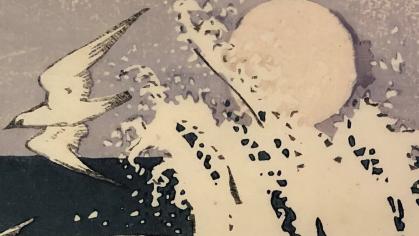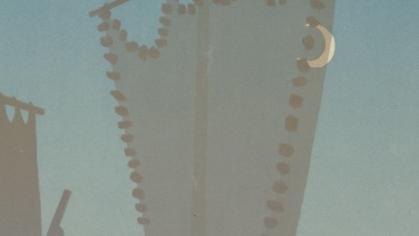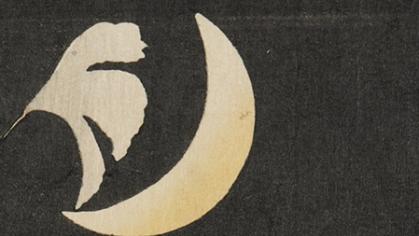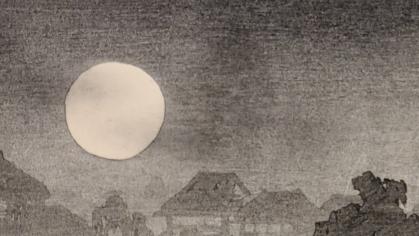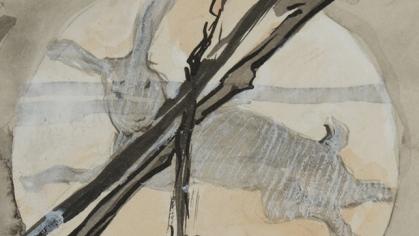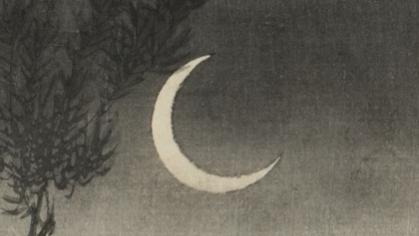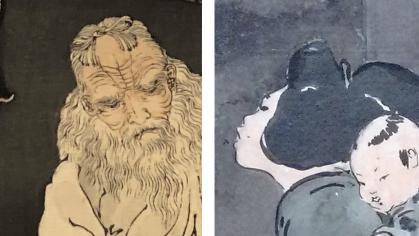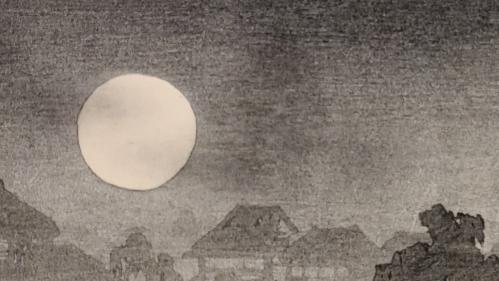
Familial Relationships and the Moon
The moon and mother/child relationships are both versatile and universal-they exist in many forms and are an important part of life. In ukiyo-e and Japanese-influenced art, the moon is used as a symbol of tranquility that brings mothers and children together. It is used as a constant, reflecting a mother’s all-encompassing love. In contrast with some of the more melancholy interpretations of the moon, the moon in the children’s world is displayed as a happy concept that children can wish upon, sing to, and talk to. Moon viewing is a communal activity that can take place in both serene and festive settings. Such images of the moon can be seen through the depiction of familial relationships and children at play in Japanese prints such as Yamamoto Shōun’s The Children Playing at Night, Ryōgoku Bridge, as well as in Helen Hyde’s illustrations for Songs of the Japanese Children.
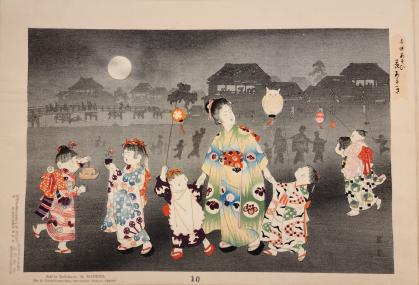
The Children Playing at Night, Ryogoku Bridge, from Twelve Months of Japanese Children's Plays
Color woodcut, 1906
Gift of Norma B. Bartman
Japanese art is the perfect medium for depicting emotive subjects and symbols. Ukiyo-e contained a subset, known as boshi-e 母子絵 (mother and child pictures), which focused specifically on children’s quotidienne lives and highlighted mother and child relationships. By highlighting how female siblings and relatives add to, help, or sometimes even replace, mothers in children’s lives, these prints also reflected the sentimentality of bonding that extended beyond motherhood.
In The Children Playing at Night, Ryōgoku Bridge, Yamamoto Shōun 山本昇雲 (1870-1965) captures a scene of traditional Japan that was rapidly disappearing in the face of modernization and Westernization. The woodblock was made in 1906, but it depicts an earlier time, a more traditional Japanese society before the influx of Western influence and culture made itself known at the start of the Meiji era. The women and children are dressed in traditional kimono at a festival carrying toys and lanterns. Like other boshi-e, this print depicts not just a mother and her child(ren) but also a doting elder sister and a younger brother.
Two vital symbolic aspects in this print are the lanterns and the moon. In Japan, as well as in some other cultures, lanterns act as mediums for wishes, messengers of our desires, prayers —especially for a good harvest or as thanks for a good harvest—and aspirations. This scene depicts a traditional tsukimi 月見 (moon-viewing festival). The abundance of lanterns helps create a mysterious and tranquil atmosphere in which children show off their lanterns and patrons sing songs about the moon. These lanterns are vehicles that carry and send wishes to the moon, directly connecting the moon and lunar celebrations to people’s intimate desires, blazing in the fiery light. The moon in return acts as the recipient of these desires, for the moon in Japanese Shinto belief is a representation of Tsukiyomi, the goddess of the moon who watches over her “children” (the people of Japan). The full moon within the print is a mangetsu 満月 (perfect full moon), meaning that this scene is as perfect as it could possibly be, with matriarchs enjoying festivities with their kin under the watchful and protective eye of Tskukiyomi. Shōun has created a scene of positivity and showcases the nostalgia for traditional Japanese culture and motherly love.
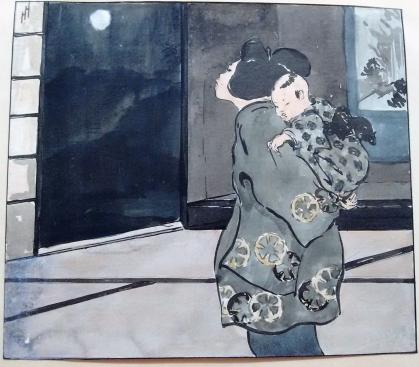
Illustration from the album Songs of the Japanese Children
Watercolor on paper, 1901
Ralph and Barbara Voorhees American Art Fund
Helen Hyde’s watercolor is for a songbook titled Songs of the Japanese Children and shows the intimacy between one mother and her baby while gazing toward the moon. In Japanese children’s songs (dōyō 童謡), the moon is a positive entity, with which viewers interact by asking questions and wishing upon. In this work, the mother holds the child on her back as they look together towards the moon. They are the only figures in a room inside the home, creating a sense that the viewer is invited into a private moment in which the mother is trying to put the child to sleep. The mother’s mouth is open as if she is singing, reflecting the illustration’s function within the songbook album. In Songs of the Japanese Children, Hyde included songs Usagi and Otsuki-san Ikutsu, both about viewers engaging with the moon. The style aligns with other boshi-e, which Hyde had been studying and directly experiencing during her time in Japan. Her prints and drawings focus on women and children in idyllic, natural settings. In this watercolor, Hyde depicts the home as a safe haven in which the mother and child are undisturbed by outside forces. Many of Hyde’s works explore the innocence of domestic life, and the illustrations for Songs of the Japanese Children align with her goals as an artist.
There are a number of commonalities between both Shōun’s print and Hyde’s illustration. The most obvious unifying factor is that both depict moon viewing, though in contrasting private and public spaces. In addition, both works also feature figures—in the Helen Hyde illustration, a mother, and in the Shōun print, an elder sister—carrying children on their backs while looking at the moon and most likely singing a song to calm the child, as is a common Japanese custom. Furthermore, both works contain mangetsu moons, or “the best” moon. This further exemplifies how these works showcase the most attractive sides of Japanese values, traditions, and heritage which the artists crave a return to and for which they are nostalgic. In these touching scenes of mothers and children, Shōun and Hyde showcased the beauty between familial relationships and the emphasis Japanese culture places on them and the tranquil lunar appreciation.
Victoria P. Kreindler (‘20) & Cara Del Gaudio (‘21)
Bibliography
Jensen, Joan M. "Helen Hyde, American Printmaker," in Women Artists of the American West, Purdue University. Accessed December 4, 2020. https://cla.purdue.edu/academic/rueffschool/waaw/jensen/hyde.html.
Kumon Museum of Children's Ukiyo-e. "Ukiyo-e by Category." Accessed December 4, 2020. www.kumon-ukiyoe.jp/ en/category.php.
Nippon.com. "'Tsukimi': The Japanese Tradition of Autumn Moon Viewing." Accessed December 13, 2020. https://www.nippon.com/en/features/jg00115/
